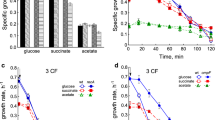Abstract
The capability of the dioxidine drug to cause bacterial resistance to antibiotics was studied. The study was performed with the use of a bioluminescent test and the recombinant E. coli strains MG 1655 (pSoxS-lux), MG1655 (pKatG-lux), MG1655 (pRecA-lux), and MG1655 (pColD-lux). The strains harbored plasmids with the operon luxCDABE from the photobacteria Photorhabdus luminescens under control of the corresponding E. coli stress-inducible promoters. The mutation frequency of the stable mutants was found by conventional methods for nonpathogenic and opportunistic strains of E. coli, Bacillus amyloliquefaciens, and Klebsiella pneumoniae. Dioxidine was shown to induce the promoters PrecA and Pcda in E. coli MG1655, which suggests the induction of the SOS-response in bacterial cells. The Pcda induction was higher than with PrecA. The value of the induction coefficient was highest if the dioxidine concentration was 2.25 × 10–5 M. Moreover, this drug enhanced the induction of the SoxS and KatG promoters responding to the superoxide anion radical and hydrogen peroxide, which suggests possible participation of oxidative mechanisms in dioxidine DNA damage. The maximal value of the induction coefficient was also observed under conditions of 2.25 × 10–5 M. Dioxidine can induce mutations leading to antibiotic resistance in all bacterial strains studied. An increase in mutation frequency was observed for rifampicin (twofold), ciprofloxacin (sixfold), and azithromycin (fourfold). These data show the necessity for an antibiogram for every patient who is taking or has taken dioxidine.
Similar content being viewed by others

References
Cirz, R.T., Chin, J.K., Andes, D.R., et al., Inhibition of mutation and combating the evolution of antibiotic resistance, PLoS Biol., 2005, vol. 3, no. 6, pp. 1024–1033. doi 10.1371/journal.pbio.0030176
Diver, J.M., Quinolone uptake by bacteria and bacterial killing, Rev. Infect. Dis., 1989, vol. 11, no. 5, pp. 941–946.
Drlica, K., Malik, M., Kerns, R.J., and Zhao, X., Quinolone-mediated bacterial death, Antimicrob. Agents Chemother., 2008, vol. 52, no. 2, pp. 385–392. doi 10.1128/AAC.01617-06
Bol’shakov, L.V., Variations in dioxidine susceptibility of clinical bacterial strains for the period from 1984 up to1988 years, Antibiot. Khimioter., 1990, vol. 35, no. 9, pp. 17–19.
Popov, D.A., Anuchina, N.M., Terent’ev, A.A., Kostyuk, G.V., Blatun, L.A., Rusanova, E.V., et al., Dioxidine: Antimicrobial activity and prospects for clinical usage nowadays, Antibiot. Khimioter., 2013, vol. 58, nos. 3–4, pp. 37–42.
Glushkov, R.G., Sokolova, G.V., Krylova, L.Yu., Stebaeva, L.F., Sharova, S.A., et al., The new combination antituberculous drug: The original combination antituberculous drug dioxazide, Probl. Tuberk. Bolezn. Legk., 2007, no. 3, pp. 20–25.
Musaev, P.I., Mamedov, L.A., and Karaeva, G.Z., Treatment of experimental corneal trauma by dioxidine and hexamine solutions, Vestn. Oftalmol., 2000, vol. 116, no. 6, pp. 20–23.
Ponomareva, T.R., Dioxidine susceptibility of clinical bacterial strains under aerobic and anaerobic conditions in vitro, Antibiot. Med. Biotekhnol., 1987, vol. 32, no. 3, pp. 199–202.
Bekbergenov, B.M., Antipov, A.V., Danil’yants, E.V., Korolev, P.N., and Glezer, G.A., Clinical and experimental examination of dioxidine. Bacterial activity, Antibiotiki, 1982, vol. 27, no. 5, pp. 349–352.
Farr, S.B. and Kogoma, T., Oxidative stress responses in Escherichia coli and Salmonella typhimurium, Microbiol. Rev., 1991, vol. 55, pp. 561–585.
Kotova, V.Yu., Manukhov, I.V., and Zavil’gel’skii, G.B., Lux-biosensors for detecting SOS response, heat shock, and oxidative stress, Biotekhnologiya, 2009, no. 6, pp. 16–25.
Karlyshev, A.V., Melnikov, V.G., and Chistyakov, V.A., Draft genome sequence of Bacillus amyloliquefaciens B-1895, Genome Announce., 2014, vol. 2, no. 3, p. e00633. doi 10.1128genomeA.00633-14
Chistyakov, V.A., Semenyuk, Yu.P., Morozov, P.G., Prazdnova, E.V., Chmykhalo, V.K., et al., Synthesis and biological properties of nitrobenzoxadiazole derivatives as potential nitrogen(ii) oxide donors: SOX induction, toxicity, genotoxicity, and DNA protective activity in experiments using Escherichia coli-based lux biosensors, Russ. Chem. Bull., 2015, vol. 64, no. 6, pp. 1369–1377.
Prazdnova, E.V., Chistyakov, V.A., Churilov, M.N., Mazanko, M.S., Bren, A.B., et al., DNA-protection and antioxidant properties of fermentates from Bacillus amyloliquefaciens B-1895 and Bacillus subtilis KATMIRA1933, Lett. Appl. Microbiol., 2015, vol. 61, no. 6, pp. 549–554.
MR (Methodological Recommendations) no. 4.2.1890-04: Guidelines for Susceptibility Testing of Microorganisms to Antibacterial Agents, Moscow, 2004.
Manuhov, I.V., Kotova, V.Yu., Mal’dov, D.G., Il’ichev, A.V., Bel’kov, A.P., and Zavil’gel’skii, G.B., Induction of oxidative stress and SOS response in Escherichia coli by vegetable extracts: The role of hydroperoxides and the synergistic effect of simultaneous treatment with cisplatinum, Microbiology (Moscow), 2008, vol. 77, no. 5, p. 523.
Lakin, G.F., Biometriya (Biometry), Moscow: Vysshaya Shkola, 1990.
Abilev, S.K., Suraikina, T.I., and Fonshtein, L.M., The way to study dioxidine inactivating and mutagenic effect onto extracellular bacteriophage T4 and Escherichia coli indicator strains, Khim.-Farm. Zh., 1978, vol. 10, pp. 18–22.
Fonshtein, L.M., Abilev, S.K., and Oblapenko, N.G., Dioxidine mutagenic effect onto bacteria, Tsitol. Genet. (Akad. Nauk Ukr. SSR), 1980, vol. 14, no. 1, pp. 60–64.
Fonshtein, L.M., Abilev, S.K., Akin’shina, L.P., Zakharova, I.A., Ivanova, N.A., Olapenko, N.G., et al., The way for investigating genetic effects of drugs and other biologically active compounds by testing mutagenesis and DNA-damaging effect, Khim.-Farm. Zh., 1978, vol. 10, pp. 11–16.
Abilev, S.K. and Abdrazakov, M.M., Organ specificity of dioxidine DNA-damaging effect, Genetika, 1991, vol. 27, no. 11, pp. 2039–2041.
Miller, C., Thomsen, L.E., Gaggero, C., et al., SOS response induction by ß-lactams and bacterial defense against antibiotic lethality, Science, 2004, vol. 305, no. 5690, pp. 1629–1631. doi 10.1126science.1101630
Instruction leaflet for medical use of the medicinal product Dioxidine, no. R No. 002534 02-2003 dated 10.04.2008.
Author information
Authors and Affiliations
Corresponding author
Additional information
Original Russian Text © M.S. Mazanko, V.A. Chistyakov, E.V. Prazdnova, I.O. Pokudina, M.N. Churilov, V.K. Chmyhalo, M.M. Batyushin, 2016, published in Molekulyarnaya Genetika, Mikrobiologiya i Virusologiya, 2016, No. 4, pp. 149–154.
About this article
Cite this article
Mazanko, M.S., Chistyakov, V.A., Prazdnova, E.V. et al. Dioxidine induces bacterial resistance to antibiotics. Mol. Genet. Microbiol. Virol. 31, 227–232 (2016). https://doi.org/10.3103/S0891416816040066
Received:
Published:
Issue Date:
DOI: https://doi.org/10.3103/S0891416816040066



